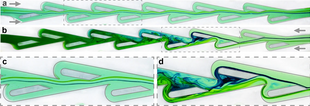
Back Vàlvula de Tesla Catalan Tesla-ventil Danish Teslaventil German Válvula de Tesla Spanish دریچه تسلا Persian Ventiel van Tesla Dutch Válvula de Tesla Portuguese Клапан Теслы Russian Tesla vanası Turkish Клапан Тесли Ukrainian


(a) Forward direction. Two adjacent filaments remain in the central corridor of the conduit with only small lateral deflections.
(b) Reverse direction. The filaments ricochet off the periodic structures, deflecting increasingly sharply before being rerouted around the 'islands' and mixing.
(c) and (d) are zoomed-in images
A Tesla valve, called a valvular conduit by its inventor, is a fixed-geometry passive check valve. It allows a fluid to flow preferentially in one direction, without moving parts. The device is named after Nikola Tesla, who was awarded U.S. patent 1,329,559 in 1920 for its invention. The patent application describes the invention as follows:[1]
The interior of the conduit is provided with enlargements, recesses, projections, baffles, or buckets which, while offering virtually no resistance to the passage of the fluid in one direction, other than surface friction, constitute an almost impassable barrier to its flow in the opposite direction.
Tesla illustrated this with the drawing, showing one possible construction with a series of eleven flow-control segments, although any other number of such segments could be used as desired to increase or decrease the flow regulation effect.
With no moving parts, Tesla valves are much more resistant to wear and fatigue, especially in applications with frequent pressure reversal such as a pulsejet.[2]

The Tesla valve is used in microfluidic applications[4] and offers advantages such as scalability, durability, and ease of fabrication in a variety of materials.[5] It is also used in macrofluidic applications and pulse jet engines.[6]

The upper figure shows flow in the blocking direction: at each segment, part of the fluid is turned around (red) and interferes with the forward flow (black).
The lower figure shows flow in the unimpeded direction (blue).
One computational fluid dynamics simulation of Tesla valves with two and four segments showed that the flow resistance in the blocking (or reverse) direction was about 15 and 40 times greater, respectively, than the unimpeded (or forward) direction.[7] This lends support to Tesla's patent assertion that in the valvular conduit in his diagram, a pressure ratio "approximating 200 can be obtained so that the device acts as a slightly leaking valve".[1]
Steady flow experiments, including with the original design, however, show smaller ratios of the two resistances in the range of 2 to 4.[6] It has also been shown that the device works better with pulsatile flows.[6]
- ^ a b Cite error: The named reference
Patentwas invoked but never defined (see the help page). - ^ Mohammadzadeh, K.; Kolahdouz, Ebrahim M.; Shirani, E.; Shafii, M. B. (2013). "Numerical study on the performance of Tesla type microvalve in a valveless micropump in the range of low frequencies". Journal of Micro-Bio Robotics. 8 (3–4): 145–159. doi:10.1007/s12213-013-0069-1. S2CID 109638783. Archived from the original on 2021-04-23. Retrieved 2021-05-12.
- ^ Forster, Fred K.; Bardell, Ronald L.; Afromowitz, Martin A.; Sharma, Nigel R. (1995). Design, fabrication and testing of fixed-valve micro-pumps. Proceedings of the ASME Fluids Engineering Division. Vol. 234. pp. 39–44.
- ^ Cite error: The named reference
microvalveswas invoked but never defined (see the help page). - ^ Cite error: The named reference
Micropumpwas invoked but never defined (see the help page). - ^ a b c Cite error: The named reference
macrovalveswas invoked but never defined (see the help page). - ^ Cite error: The named reference
CFDwas invoked but never defined (see the help page).
© MMXXIII Rich X Search. We shall prevail. All rights reserved. Rich X Search